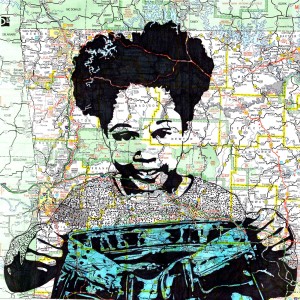
Kamryn Gardner
First grader who asked Old Navy to make jeans with pockets
The Artwork:
Gardner’s portrait in the Fearless Portraits project consists of an Ink drawing of her holding her new pocketed jeans on a map of northern Arkansas. Bentonville, where she lives is located just over her head and the left.
The Story:
Seven-year-old Kamryn Garder of Bentonville, AR had a small problem: Her pants had no pockets. She desperately wanted pockets to put her hands in and stash items. Her brother’s pants had pockets but on hers, the “pockets” were strictly ornamental.
After learning about persuasive writing in school, the first grader put the lesson into action. On the advice of her mother, she wrote a letter to retailer Old Navy. With neat penciled letters on large-ruled paper, she took the company to task for shortchanging girls out of their pockets
Dear Old Navy,
I do not like that the front pockets of the girls jeans are fake. I want front pockets because I want to put my hands in them. I also would like to put things in them. Would you consider making girls jeans with front pockets that are not fake. Thank you for reading my request.
Sincerely,
Kamyrn Gardner, age 7
Gardner’s brother, Landon, 9, found her argument persuasive, saying, “I’ve never had this problem [of no pockets]. But I’ve heard my sister talk about not having pockets all the time.”
The logic worked on Old Navy also and the company responded with a note about her “great feedback for us as we develop new product,” and a package of four pairs of jeans in her size. With pockets of course.
Less successful was Gardner’s efforts at writing persuasive letters to her parents to get her a camera.
Background on pockets in women's and girl's clothes
Gardner isn’t the first to rail against the lack of functional pockets in women’s clothing. Women lost their pockets two centuries ago, when closer-fitting dress styles came in vogue in the 1790s. Before then, women’s pockets were essentially bags hanging from a strap around the waist and tucked under a skirt. With fluffy skirts and petticoats, the pockets were invisible. When styles changed, pockets were left behind to avoid bulges. Meanwhile, men have always enjoyed pockets.
Beginning in the 20th century, pockets for women have repeatedly come back, only to leave again, depending who’s winning the tug-of-war between practicality and fashion, (or if you prefer, empowerment and misogyny). as Christian Dior put it, “Men have pockets to keep things in, women for decoration.”
Gardner’s complaint is about more than having a place for her hands. As writer Gail Cornwall noted in The Washington Post:
“Not having pockets limits girls’ ability to experience. Not only do pockets free a child’s hands to investigate and accomplish, they also broadcast the need and right to do so to both wearer and viewer alike. Or, more accurately, it’s the contrast of the presence and absence of pockets in different kids’ clothing that sends a two-part message: Only men need functionality, and girls should learn to be women as early as possible.”
Music:
This episode contains music by Geovane Bruno, Coma Media, and Music Unlimited.
Sources:
- Bentonville Schools [@ BentonvilleSchools]. (2021, April 1). Oh, the power of persuasion especially when you’re adorable! Earlier this year, first graders at Evening Star Elementary practiced writing [Facebook post]. Facebook. https://www.facebook.com/BentonvilleSchools/posts/10157778570856366
- Burman, B. (2002). Pocketing the Difference: Gender and Pockets in Nineteenth-Century Britain. Gender History, 14(3), 447–469. https://doi.org/10.1111/1468-0424.00277
- Cornwall, G. (2020, January 15). Why girls need pockets. Washington Post. https://www.washingtonpost.com/outlook/2020/01/15/why-girls-need-pockets/
- Free, C. (2021, April 9). First-grader wrote Old Navy asking for girls’ jeans to have real pockets. The letter went viral. Washington Post. https://www.washingtonpost.com/lifestyle/2021/04/09/old-navy-girls-jeans-pockets/
- Pelletiere, N. (2021, April 8). Old Navy responds to 1st grader’s request for girls’ jeans with real pockets. Good Morning America. https://www.goodmorningamerica.com/family/story/navy-responds-1st-graders-request-girls-jeans-real-76923645
- Ushe, N. (2021, April 8). Old Navy Tells First-Grader They Plan to Develop Pockets in Girls’ Jeans After She Writes Them a Letter. PEOPLE.Com. https://people.com/human-interest/old-navy-tells-first-grader-they-plan-develop-pockets-girls-jeans-after-letter/
More Episodes
 2023-06-22
2023-06-22
 2022-04-12
2022-04-12
Create your
podcast in
minutes
- Full-featured podcast site
- Unlimited storage and bandwidth
- Comprehensive podcast stats
- Distribute to Apple Podcasts, Spotify, and more
- Make money with your podcast
It is Free
- Privacy Policy
- Cookie Policy
- Terms of Use
- Consent Preferences
- Copyright © 2015-2024 Podbean.com






